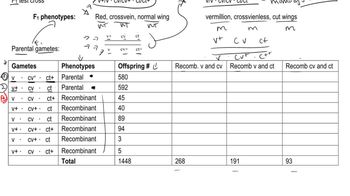Table of contents
- 1. Introduction to Genetics51m
- 2. Mendel's Laws of Inheritance3h 37m
- 3. Extensions to Mendelian Inheritance2h 41m
- 4. Genetic Mapping and Linkage2h 28m
- 5. Genetics of Bacteria and Viruses1h 21m
- 6. Chromosomal Variation1h 48m
- 7. DNA and Chromosome Structure56m
- 8. DNA Replication1h 10m
- 9. Mitosis and Meiosis1h 34m
- 10. Transcription1h 0m
- 11. Translation58m
- 12. Gene Regulation in Prokaryotes1h 19m
- 13. Gene Regulation in Eukaryotes44m
- 14. Genetic Control of Development44m
- 15. Genomes and Genomics1h 50m
- 16. Transposable Elements47m
- 17. Mutation, Repair, and Recombination1h 6m
- 18. Molecular Genetic Tools19m
- 19. Cancer Genetics29m
- 20. Quantitative Genetics1h 26m
- 21. Population Genetics50m
- 22. Evolutionary Genetics29m
2. Mendel's Laws of Inheritance
Probability and Genetics
Problem 41b
Textbook Question
Textbook QuestionStudents taking a genetics exam were expected to answer the following question by converting data to a 'meaningful ratio' and then solving the problem. The instructor assumed that the final ratio would reflect two gene pairs, and most correct answers did. Here is the exam question: 'Flowers may be white, orange, or brown. When plants with white flowers are crossed with plants with brown flowers, all the F₁ flowers are white. For F₂ flowers, the following data were obtained: 48 white 12 orange 4 brown Convert the F₂ data to a meaningful ratio that allows you to explain the inheritance of color. Determine the number of genes involved and the genotypes that yield each phenotype.' We now have a dilemma. The data are consistent with two alternative mechanisms of inheritance. Propose an experiment that executes crosses involving the original parents that would distinguish between the two solutions proposed by the students. Explain how this experiment would resolve the dilemma.
 Verified Solution
Verified SolutionThis video solution was recommended by our tutors as helpful for the problem above
Video duration:
1mPlay a video:
Was this helpful?
Key Concepts
Here are the essential concepts you must grasp in order to answer the question correctly.
Mendelian Inheritance
Mendelian inheritance refers to the principles of heredity established by Gregor Mendel, which describe how traits are passed from parents to offspring through discrete units called genes. In this context, the inheritance of flower color can be analyzed using Mendel's laws, particularly the law of segregation and the law of independent assortment, which help predict the ratios of phenotypes in offspring based on parental genotypes.
Recommended video:
Guided course

Organelle Inheritance
Phenotypic Ratios
Phenotypic ratios represent the relative frequencies of different phenotypes in the offspring resulting from a genetic cross. In the given problem, the F₂ generation's flower color data (48 white, 12 orange, 4 brown) can be converted into a ratio of 12:3:1, suggesting a specific inheritance pattern. Understanding how to interpret these ratios is crucial for determining the underlying genetic mechanisms.
Recommended video:
Guided course

Mutations and Phenotypes
Experimental Design for Genetic Crosses
Experimental design in genetics involves planning controlled crosses to test hypotheses about inheritance patterns. To resolve the dilemma of alternative inheritance mechanisms, one could perform test crosses with the F₁ generation and the original parental plants. By analyzing the resulting offspring's phenotypes, one can determine which genetic model accurately explains the observed ratios, thus clarifying the genetic basis of flower color inheritance.
Recommended video:
Guided course

Trihybrid Cross
Related Videos
Related Practice




